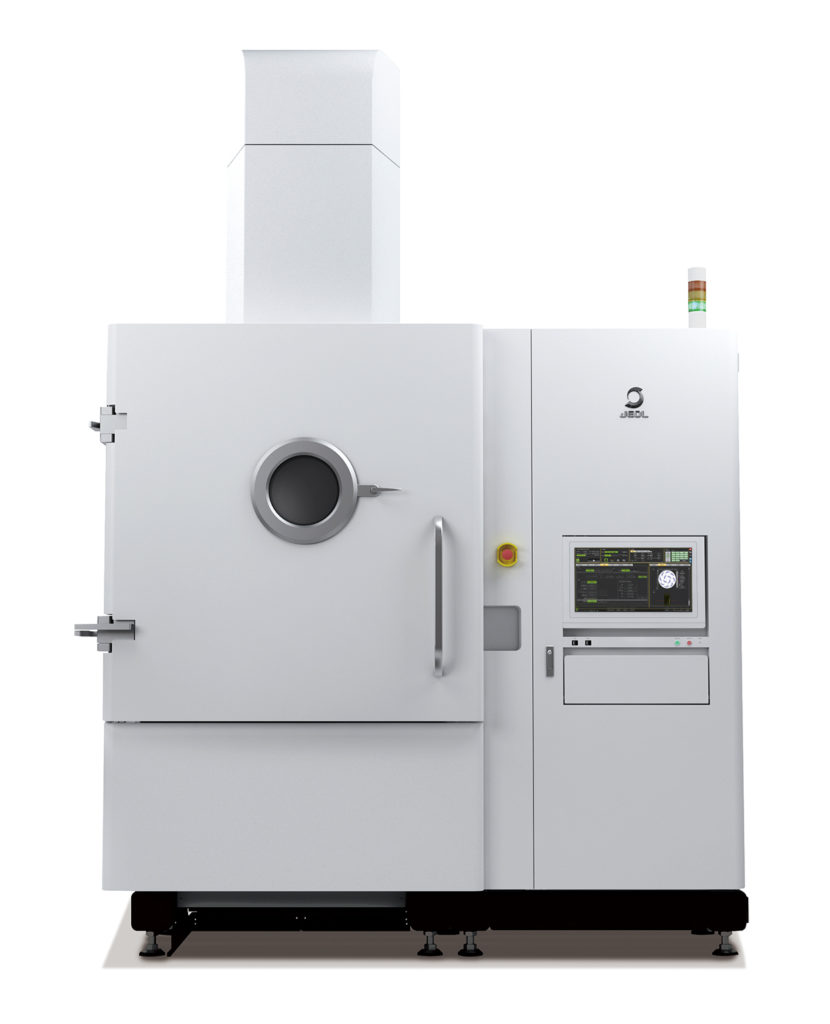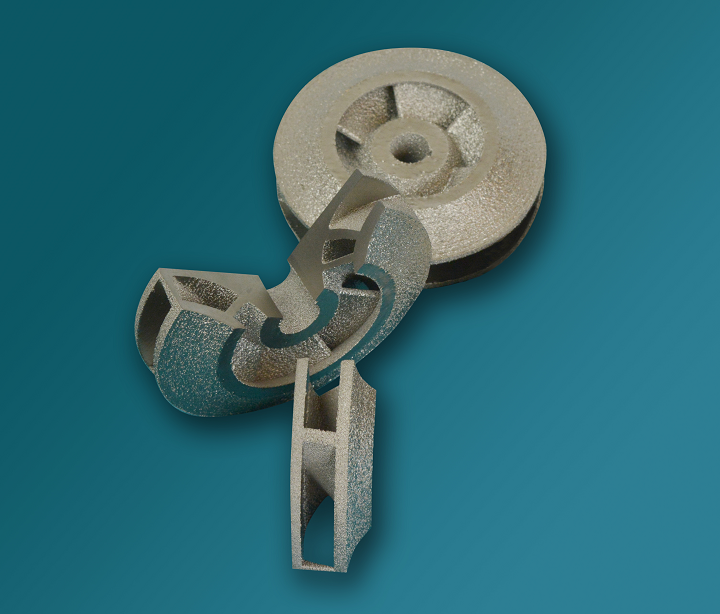The dam that once separated the additive manufacturing (AM) industry from mainstream manufacturing has finally broken. As the waters merge, numerous companies that previously existed outside of 3D printing are finding entry points into the sector. This includes Japan’s JEOL Ltd. (TYO: 6951), which debuted its JAM-5200EBM electron beam metal 3D printer to a North American audience at RAPID + TCT 2022.
With a market cap of roughly USD$2.4 billion, JEOL is a leading maker of electron microscopes and other scientific, industrial, and medical equipment. Its expertise in electron beams and expertise in industrial manufacturing were the perfect combination to send the company into the electron beam powder bed fusion (E-PBF) space. There, as one of just a handful of players, JEOL is primed to lead a new generation of E-PBF systems to disrupt a subsegment previously monopolized by GE Additive’s Arcam.
At RAPID, we spoke to Robert Pohorenec, President of JEOL USA, along with Zane Marek, Product Manager at JEOL USA. The team was able to tell us about how exactly the company and its product set JEOL apart from others in this cozy space.
A History in Electron Beams
“We got into this sideways,” Pohorenec said. “We’ve been making electron microscopes for 72 years now, with the company making transmission electron microscopes in Japan. We added other instrumentation to that portfolio—some of it electron beam-based, some of it made up of analytical chemistry instruments, like nuclear magnetic resonances. We make mass spectrometers and medical equipment. Then, in 2014, the JEOL factory joined a consortium in Japan to help establish a stronger additive manufacturing industry in the country—many different techniques, not just electron beam. This instrument that we’re bringing to market was generated as a result of that government-funded initiative to bring an e-beam powder bed manufacturer to Japan.”
According to the JEOL USA president, it’s the company’s extensive experience in both electron beam and manufacturing that gives it a leg up in the additive industry. This includes not just imaging and metrology tools, but industrial equipment, such as electron beam lithography equipment for the mass production of semiconductors.
“Those are very demanding customers. We’re used to living with that kind of demand—the customer demand on time to repair, uptime, and availability of instrumentation. We’re very familiar with the expectations that industry has on cost of ownership and managing cost of ownership. For us, this is not our first foray into getting into something that’s a few degrees of separation away from our bread and butter,” Pohorenec said.
Included in its long period of manufacturing is what is now a broad service network and the ability to handle customers. JEOL has sales bases in over 30 countries around the world, including 17 overseas corporations located in the USA, Europe, Australasia and Asia. This means that it can not only introduce its E-PBF system around the world quickly, but it can also service those customers when necessary.
Improvements to Electron Beam 3D Printing
Not only does the JEOL’s E-PBF carry with it the weight of a large corporation, but it also introduces some technological advances over legacy E-PBF machines. For instance, the JAM-5200EBM includes the “World’s Longest Life Cathode,” according to JEOL. This allows the cathode to operate for 1,500 hours or more, thus cutting downtime between cathode replacement.
“We guarantee 1,500 hours of lifetime, which is double what anyone else can do,” Marek said. “That’s only because we know the vacuum system, just having developed so much of it in the past seven decades. So, we’re able to use all of that and combine it with our electron beam lithography for the scanning. It’s a very stable proven system, because we have to please the people that make the chips in our phones. They’re very demanding. So, we use all of that and we incorporate all of that inside the EBM system.”
Additionally, it doesn’t require the use of helium gas, maintaining print quality over time and reducing costs. Instead, the machine’s e-Shield system prevents the scattering of powder during printing, further ensuring print quality and overcoming a general issue with legacy E-PBF processes. The electron beam can also be focused automatically to ensure consistent quality and repeatability. Finally, the JAM-5200EBM can be monitored remotely.
“We have the e-Shield, which prevents smoke events and other issues from happening to the powder that are undesirable,” Marek elaborated. “Then, we combine that with the unique pre-scan strategy. We can heat up the print bed and also heat up localized areas. We give the user about seven or eight different parameters that they can adjust. There’s no black box—as in, either scan on or scan off. We give them the recipe. We give them the freedom to explore and to adjust the parameters on their own.”
JEOL in the 3D Printing Market
The company officially introduced the JAM-5200EBM to the European market in November 2021 at Formnext. It already has a beta machine installed in the lab of Professor Akihiko Chiba at the Institute for Materials Research at Tohoku University. With its foray into the North American market, it won’t be alone.
GE’s Arcam is the legacy manufacturer of E-PBF machines and could very well be working on improving its process as new competitors enter the field. In addition to JEOL, there’s FreeMelt, which has an open architecture machine, as well as Xi’an Sailong Metals in China, and Wayland Additive in the U.K. Wayland claims to overcome some of the same issues that JEOL does and has a similar background in semiconductors. In addition to overcoming the need for inert gases, Wayland suggests that its electron beam system produces parts that do not experience residual stress.
Moving forward, JEOL aims to develop a research-level machine for materials development, as well as in-situ monitoring, in the next five to 10 years. This will be performed with funding from the Japanese government. Ultimately, the company plans to sell 10 units annually at a price of ¥180,000,000 (about USD$1.6 million). While this may not be JEOL’s main source of revenue for the time being, it would be interesting to see the business chip away at Arcam’s market share and ultimately used for mass production in the same way that Arcam machines are.
Images courtesy of JEOL.
Subscribe to Our Email Newsletter
Stay up-to-date on all the latest news from the 3D printing industry and receive information and offers from third party vendors.
You May Also Like
3D Printing News Unpeeled: A $3000 SLS System, Construction Subsidies and Parameters
The Housing Affordability Crisis is one of Canadian President Trudeau’s biggest issues. Now the government has made subsidies available, including scaling new technologies, 3D printed housing and libraries of reapproved...
“Bundled Light” Enables High Quality Plastic 3D Printing from LEAM
Naturally, we expect current 3D printing methods to continuously improve, but it continues to do so in the most surprising ways. The latest development comes from LEAM, a startup spun...
Each to Their Own: Exploring Creality’s Latest Ender Trio as the Company Strengthens Its Commitment to 3D Printing Advocacy
Creality has reaffirmed its commitment to promoting 3D printing. The launch of the Ender-3 V3 SE, Ender-3 V3 KE, and Ender-3 V3 showcases the company’s dedication to catering to diverse...
3D Printing News Briefs, March 23, 2024: AM in the US Coast Guard, Navy, & More
In today’s 3D Printing News Briefs, we’re discussing the use of 3D printing in various branches of the military, including the U.S. Coast Guard, the U.S. Navy, and the German...




































